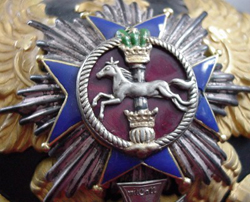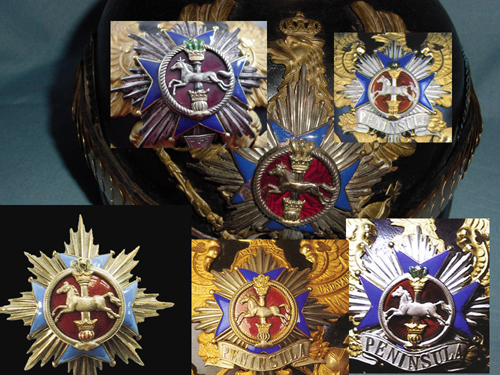The Brunswick Running Horse Wappen.
Joseph P. Robinson.
29 November 2005.
The single most popular helmet is that of the first and second Battalion 92nd Infantry Regiment, prior to 1912. The acquisition of the Neumann catalog brought up a few points about the enamel wappen. The example I will use is the very popular running horse wappen from Brunswick or Braunschweig. There have been a lot of questions about this wappen as the prices commanded by this popular helmet have soared. Arguments about paint and the amount of enamel went back and forth. Stubbs does a great job in his book, taking one apart. The general consensus was less enamel = less likely to be original. Lots of questions and lots of ideas.
What this catalog shows us is that there were four qualities of the enamel center of the wappen.
1. A helmet with gilded metal, silvered star, and lacquered wappen.
2. A helmet with heavy gilded metal, and lacquered wappen.
3. A helmet with heavy gilded metal, the center of the wappen enameled. But the cross on the wappen is lacquered.
4. A helmet with a genuinely silvered star and a totally enamel wappen.
Of course there are many manufacturers of the wappen all with its different twists. The style of horses were different. And the central post with a green top is enameled in some examples and painted in others.


I cannot attest that either of the two above examples are from Neumann. The example on the right has red in the mask of the crown. The example on the left no longer has any evidence of that color. One interesting point is that the top-of-the-line wappen cost 50% more than the bottom of the line.
In volume 1 of his excellent two-volume series. The French author Lacarde laments that there are many running horse fakes. He alludes to the fact that in some cases, the enamel is just not right. While I am positive that the author has seen some phony enamel, the catalog quote above should prove that not all of these wappen were enameled. But why so many? It certainly seems that there are more of these than one would expect from two battalions of use prior to 1912. The answer is in the landwehr. All officers under the Bezirkscommando wore this wappen. All other than active units in XCorps are suspect at the least. This excerpt from “Das Deutsche Heer” bares this point out.

|
|||||||



